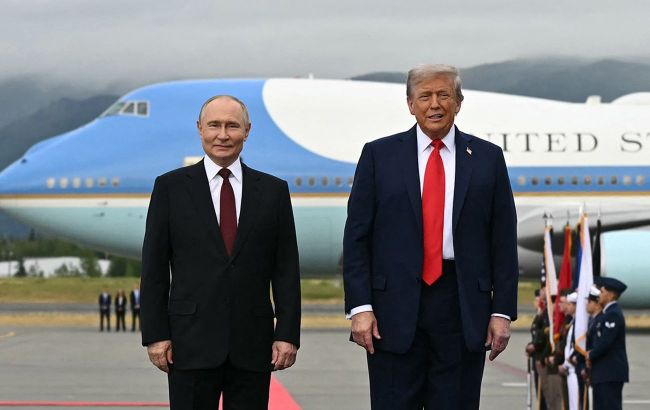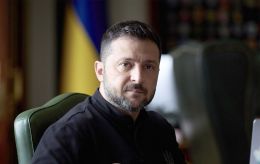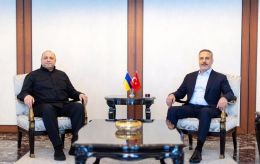Trump and Putin meet in Alaska
 Photo: Donald Trump and Vladimir Putin (Getty Images)
Photo: Donald Trump and Vladimir Putin (Getty Images)
US President Donald Trump and the Russian leader met in Anchorage, Alaska. They will hold talks with the war in Ukraine as the central topic.
Details are below in an RBC-Ukraine report.
Key questions:
-
What is known about the Trump–Putin meeting in Alaska, and why it is called historic
-
What preceded the summit, at which the US hopes to move closer to ending the war in Ukraine
-
What’s behind the Kremlin's proposals and the US position
-
What is known about plans for a potential Trump–Zelenskyy–Putin trilateral summit
-
The disputes over Ukrainian territories
The leaders met on the red carpet at Anchorage Airport, shook hands, and got into a car headed to the talks venue.
Journalists managed to ask the Russian president about the war, but he dodged the question.
When asked, "President Putin, will you stop killing civilians?” he gestured as if he could not hear the question due to the aircraft engine noise.
Why the Alaska meeting is historic
Vladimir Putin is visiting the US for the first time in a decade — his last trip was to New York in 2015 for the UN General Assembly. Today's Alaska summit is the first in-person meeting between the Russian and US leaders since 2021, when Putin met then-President Joe Biden in Geneva.
Putin's last one-on-one talks with Donald Trump were in 2018 in Helsinki; the following year, they met again at the G20 summit in Japan as part of delegations. Since Trump returned to the White House in early 2025, they have spoken by phone at least six times.
Today's meeting is taking place at the Elmendorf–Richardson US military base for security reasons.
The choice of location was limited because of the ICC arrest warrant for Putin. Russia rejected a meeting in Europe, and the White House found the UAE unsuitable. This left Hungary and the US, and Putin's agreement to meet in Alaska surprised Washington.
Alaska, as a US territory, is outside the jurisdiction of the ICC, meaning the arrest warrant has no effect there.
The meeting also has historic symbolism: it is the first time US and Russian leaders have met on land that once belonged to the Russian Empire before being sold to America in 1867.
War in Ukraine – main focus of talks
The summit's main topic is the war in Ukraine. The US emphasizes it wants to achieve a ceasefire. The Russian and US delegations will also touch on bilateral relations.
Initially, the leaders were expected to meet one-on-one (with only interpreters present) before moving to delegation-level talks.
However, NBC News, citing a senior White House official, reported that the previously planned face-to-face meeting will now be in a three-on-three format, with US Secretary of State Marco Rubio and Trump's special envoy Steve Witkoff joining.
Trump's delegation includes:
- Marco Rubio, Secretary of State;
- Scott Bessent, Treasury Secretary;
- Howard Lutnick, Commerce Secretary;
- John Ratcliffe, Director of National Intelligence;
- Susie Wiles, White House Chief of Staff;
- James Blair, White House Political Director;
- Beau Harrison, Deputy Chief of Staff;
- Nick Luna, Communications Director;
- Dan Scavino, Deputy Communications Director;
- Stephen Cheung, Press Secretary;
- Robert Gabriel, National Security Advisor;
- Caroline Levitt, Press Secretary;
- Will Scharf, Legal Counsel;
- Ross Worthington, Economic Policy Advisor;
- Steve Witkoff, Special Envoy;
- Monica Crowley, Chief of Protocol.
The Russian delegation includes:
- Sergey Lavrov, Foreign Minister;
- Yuri Ushakov, Presidential Aide;
- Andrey Belousov, Defense Minister;
- Anton Siluanov, Finance Minister;
- Kirill Dmitriev, Russian Direct Investment Fund head.
Both the Kremlin and the White House have announced a joint press conference after the talks. However, Trump has not ruled out addressing the press alone if the meeting goes badly. He has estimated there's a 25% chance the talks will fail.
Trump also expressed doubt that he could convince Putin to stop attacks on Ukrainian civilians, noting, "I always hang up and say, that was a nice phone call, and then missiles into Kyiv or some other city."
The summit follows Trump's ultimatum to Russia to agree to a peace deal.
On the eve of the meeting, Trump held a video conference with Volodymyr Zelenskyy and EU leaders, assuring them he would not discuss Ukraine's territorial integrity without Kyiv's participation.
Trump hopes Putin will make a deal, but is not sure it will happen immediately after Alaska. "He (Putin - ed.) knows I'm the toughest opponent he's ever dealt with," Trump said.
No documents are expected to be signed after the meeting.
Kremlin ultimatums and Kyiv's position
The Wall Street Journal reported that the Kremlin proposed halting hostilities in exchange for Ukraine handing over part of Donbas (still under Ukrainian control) and Crimea.
President Zelenskyy firmly rejected the idea, stressing that Ukraine's territorial integrity is enshrined in the Constitution and warning that Russia is preparing new offensives.
"Donbas for the Russians is a springboard for a new offensive. If we leave Donbas voluntarily or under pressure, we open the door to a third war," Zelenskyy said.
EU leaders have also insisted that any peace deal must involve Ukraine directly.
Zelenskyy said five key principles were agreed in the pre-summit talks — from security guarantees to tougher sanctions if Russia refuses a ceasefire.
Plans for Trump–Putin–Zelenskyy trilateral meeting
Trump has announced a possible trilateral meeting next week, but says he will decide after the August 15 summit. Zelenskyy is ready to meet Putin in any format, while Putin is reportedly reluctant.
The US president also said he is considering three possible locations for the next round of talks with the leaders of Ukraine and Russia.
According to RBC-Ukraine sources, Zelenskyy is ready to meet with the Russian leader in any format, while Putin is "not so much."
"President Trump really wants to end this war, just like Ukraine does. We need to hold three meetings — two bilateral and one trilateral. And probably after the trilateral, we will have a result," the Ukrainian president told the media.
When asked why Zelenskyy was not included in the August 15 meeting, White House Press Secretary Caroline Levitt said Trump agreed to this meeting at President Putin's request. She added that she hopes the three leaders will be able to meet together soon.
Although Trump initially promised to call Zelenskyy and European leaders after the summit with Putin, he later adjusted his position, saying he would only make those calls if there was progress in Alaska to move things forward.
If the summit fails, the US has said it is ready to move to new economic restrictions against Russia and its allies — likely referring to a Senate bill introducing tariffs on imports from countries that purchase Russian energy resources.
Territorial dispute and security guarantees for Ukraine
The US leader described today's meeting with Putin as a dispute over borders and land. While Trump has insisted he will not discuss dividing Ukrainian territory with Putin, he and his administration generally consider "territorial swap" a necessary part of a potential deal between Ukraine and Russia.
US Secretary of State Marco Rubio has said that peace in Ukraine would require both security guarantees and territorial exchanges.
He explained that Trump is going into talks with Putin hoping to achieve a halt to hostilities in Ukraine's war, but a comprehensive resolution of the conflict will take more time.
"I think we all recognize that in order to achieve peace, we need to discuss security guarantees. You have to discuss... territorial disputes and claims and what they're fighting for," Rubio said.
He stressed that the US president hopes to achieve some kind of stop to the fighting, after which these talks will take place.
Zelenskyy, on the other hand, called the exchange of territory a complex issue that cannot be separated from security guarantees for Ukraine and the country's sovereignty.
The Ukrainian president insists that it is necessary to understand Putin's objectives and the messages he constantly conveys. "Then it will become clear what is happening and what the dictator is doing," Zelenskyy said.
He also outlined his plan for ending the war.
"It’s very simple: ceasefire, and during the ceasefire we must discuss and resolve the issues — with US mediation and clear security guarantees — who can guarantee what. For example: what Europe can guarantee, what the US can guarantee, what the Russians can guarantee. There must be an agreed position," Zelenskyy stated.
According to Politico, the US is indeed ready to discuss security guarantees for Ukraine — but only if these efforts are not implemented within NATO.
For more on what led up to the US–Russia summit in Alaska and what to expect next, see the analytical report by RBC-Ukraine.

